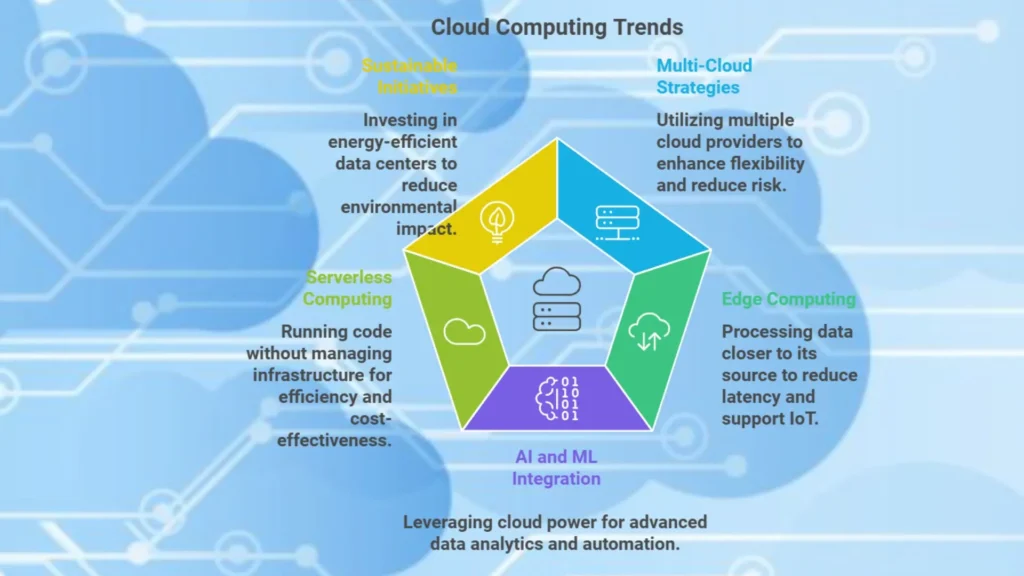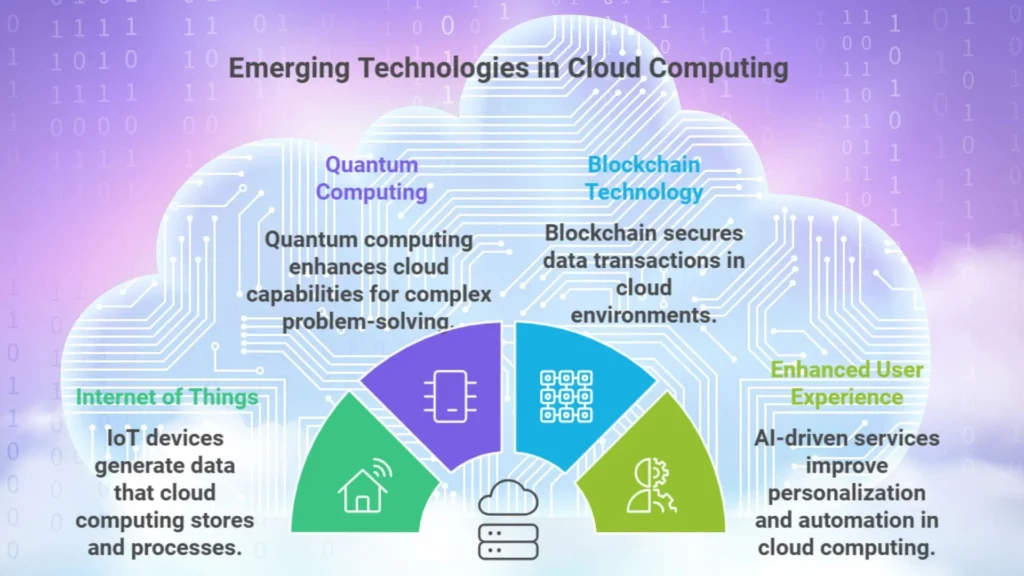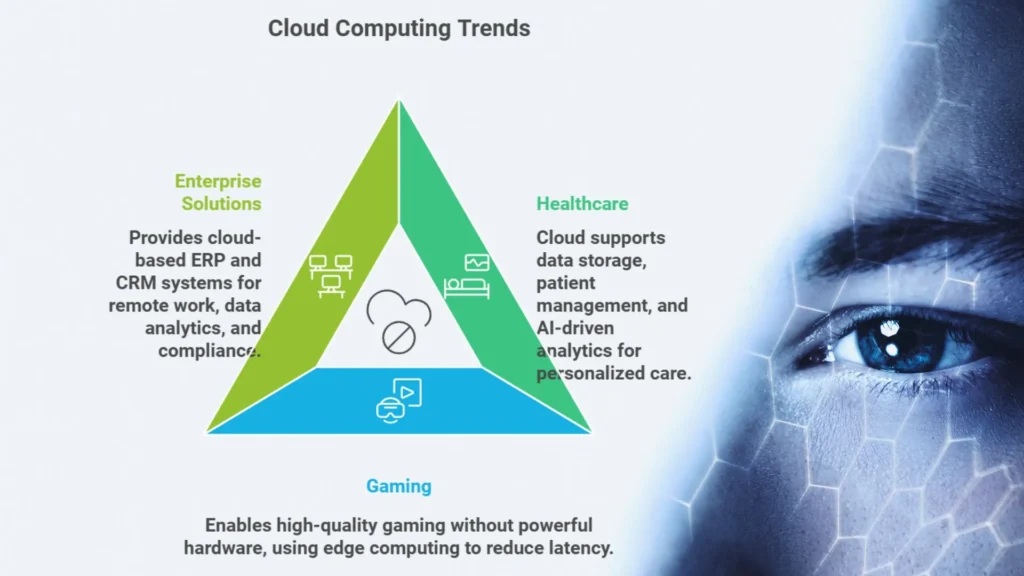Cloud computing is rapidly evolving and with latest trends and technologies it is shaping its future across industries. In the coming years, we can expect cloud computing to further revolutionize the way businesses operate, manage data and support innovative applications.
Here we look at some of the most promising trends in cloud computing, their potential impacts and what they mean for industries like gaming, healthcare and enterprise solutions. We will discuss in detail what is The Future of Cloud Computing.
Key Trends in Cloud Computing
1. Multi Cloud and Hybrid Cloud Strategies
– Multi Cloud: Companies are increasingly using multiple cloud providers to distribute their workloads. This approach, known as multi cloud, helps minimize reliance on a single vendor, reduces risk and allows organizations to use each provider’s unique strengths.
– Hybrid Cloud: Hybrid cloud combines private and public cloud infrastructures, which allows businesses to keep sensitive data on premises while using cloud resources for scalability. This is particularly beneficial for industries with strict data regulations, such as healthcare.
2. Edge Computing
– Definition: Edge computing involves processing data closer to its source rather than relying on a central data center. This reduces latency, enhances real time data processing and supports IoT applications.
– Applications: With edge computing, applications that require low latency, like autonomous vehicles, smart cities, and real time gaming etc. can operate with minimal delays. This will improve user experience and operational efficiency. With the development of IoT devices, edge computing is becoming essential for managing and analyzing the large amounts of data generated at the network’s edge.
3. Artificial Intelligence (AI) and Machine Learning (ML) Integration
– AI and Cloud Synergy: The cloud offers the computational power needed for complex AI and ML algorithms, which makes advanced data analytics accessible to companies of all sizes.
– Impact: AI driven information can help industries, such as healthcare and finance, to make informed decisions and provide personalized services. This trend enables businesses to automate processes and enhance predictive analytics. This will drive innovations in various fields, like healthcare, finance and customer services.
4. Serverless Computing
– Definition: Serverless computing enables developers to run code without managing the underlying infrastructure. The cloud provider automatically handles server allocation and scaling.
– Advantages: This model is cost effective and simplifies deployment, which makes it easier for developers to focus on code rather than infrastructure. Serverless computing is ideal for scalable apps, microservices and real time data processing. These are ideal for event driven applications, where resources are automatically allocated based on demand. This arrangement ensures efficient resource utilization.
5. Sustainable Cloud Initiatives
– Green Cloud: With a growing emphasis on sustainability, cloud providers are investing in energy efficient data centers, which uses renewable energy and optimizes resource allocation to reduce environmental impact.
– Benefit: Sustainable cloud solutions allow companies to reduce their carbon footprint and support eco friendly practices, which appeals to consumers and stakeholders who prioritize environmental responsibility.
6. Security and Compliance
Advanced Security Measures: As cyber threats evolve, cloud providers are continuously enhancing their security features. Future developments include zero trust architectures, AI driven threat detection and improved encryption methods.
Regulatory Compliance: With increasing data privacy regulations, cloud providers are focusing on compliance features to help businesses to meet legal requirements and protect sensitive information.

Emerging Technologies Shaping Cloud Computing
Following are key technologies and features that are poised to shape the future:
1. Internet of Things (IoT)
– Internet of Things (IoT) devices generate large amounts of data, and cloud computing offers scalable solutions to store and process this data. Edge computing enhances IoT applications by enabling faster data processing closer to the source.
2. Quantum Computing
– Quantum computing, though still emerging, has the potential to solve complex problems beyond the reach of classical computing. When combined with cloud computing, it could revolutionize problem solving and data processing capabilities, to tackle complex computation tasks that are currently not feasible like cryptography, pharmaceuticals and logistics.
3. Blockchain Technology
– Blockchain’s decentralized nature enhances data security, especially for financial transactions. In cloud environments, blockchain can create secure, transparent systems for data sharing and access.
4. Enhanced User Experience
Personalization and Automation: The future of cloud computing will see more personalized and automated services, which enhances user experience and productivity. AI driven personalization and intelligent automation will streamline workflows and decision making processes.

Industry Specific Cloud Trends
1. Healthcare:
Cloud computing supports healthcare organizations with data storage, patient management and compliance. AI driven analytics on cloud platforms enable early diagnosis and personalized care.
2. Gaming:
Cloud gaming allows users to play high quality games without needing powerful local hardware, which enables “gaming-as-a-service.” Edge computing also minimizes latency, essential for immersive gaming experiences.
3. Enterprise Solutions:
Cloud based ERP and CRM systems support remote work, data analytics and collaboration. Also, hybrid solutions ensure data privacy and regulatory compliance.

Conclusion
The future of cloud computing promises exciting advancements and innovations. By staying ahead of these trends, businesses can harness the power of cloud technologies to drive growth, enhance efficiency and remain competitive in this developing digital age. Businesses that embrace these changes can look forward to enhanced flexibility, efficiency and growth opportunities.


Nice website, clean layout. Similar content at HumanWhisper.